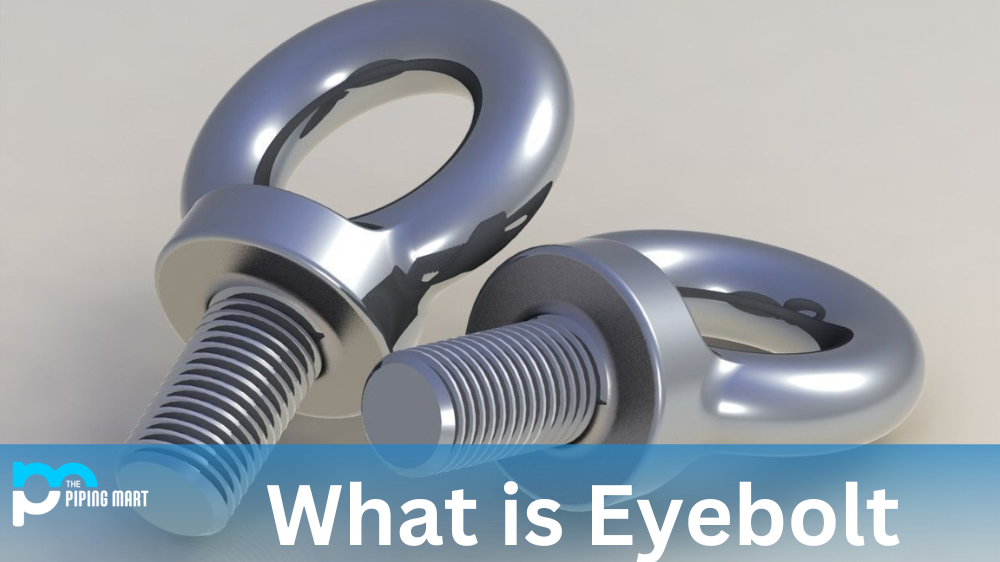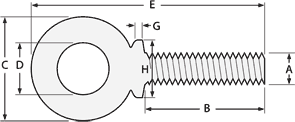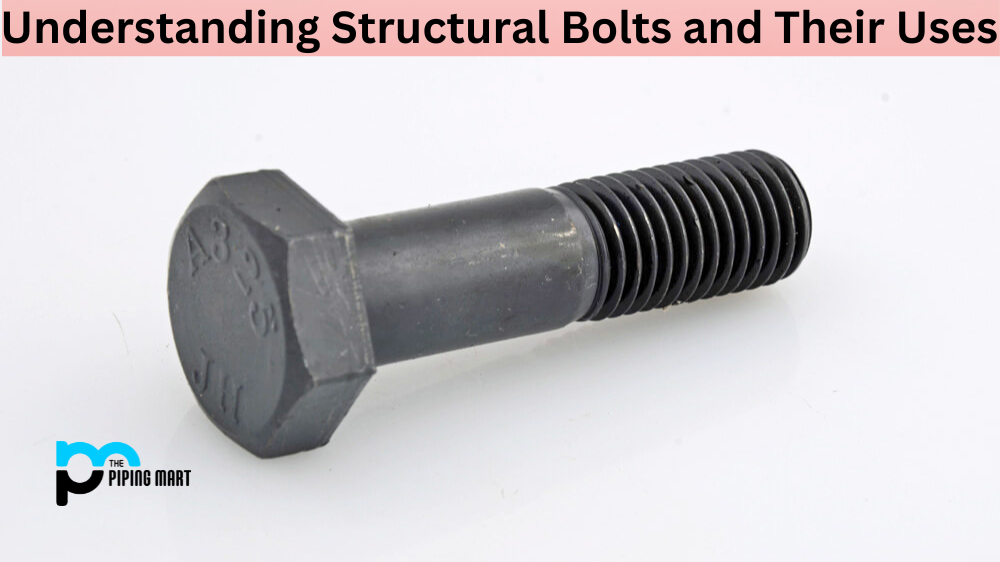An eyebolt is a tool used to secure objects. It is made up of two parts, the eye, and the bolt. The eye is typically circular, allowing for multiple mounting positions, and is often threaded internally or externally so that it can be attached to a corresponding nut or hook. The bolt portion of the eyebolt consists of either a shaft with a screw thread at one end or two shafts with an enclosed loop between them. It’s important to note that an eyebolt should never be used in place of an anchor or other load-bearing hardware.
Types of Eye bolts
There are several different types of eyebolts available on the market today. These include open-eye bolts, closed-eye bolts, swivel-eye bolts, lag screws, and toggle bolts. Each type has its own unique characteristics and benefits depending on your application needs.
- Open-Eye Bolts: Open-eye bolts have an exposed eye that allows for multiple mounting positions and is best suited for lighter loads such as those found in draperies or light fixtures.
- Closed-Eye Bolts: Closed-eye bolts feature a closed eye that allows for just one mounting position but provides more strength than open-eye bolts due to their sturdier construction.
- Swivel-Eye Bolts: Swivel-eye bolts feature an adjustable eye that allows for multiple positioning options while providing greater flexibility than other eyebolts.
- Lag Screws: Lag screws are ideal for heavier loads as they are designed to provide maximum holding power against large weights and forces.
- Toggle Bolts: Toggle bolts are best suited for use in hollow walls where there is no access to the back side of the wall – they work by expanding once inserted into the hole and locking into place when tightened down on the opposite side.
Eye bolt Uses
Eyebolts are essential items for carpentry, home improvement and do-it-yourself projects. They are a simple way to hang decorations, certain items from falling and stabilize walls. Using an eyebolt, you can easily attach pipes, wires, planks and other structural loads. Furthermore, due to their strong anchoring quality, they can even be used in mechanical engineering works and automotive applications. Safety is also of utmost importance when it comes to using eyebolts. Thus proper positioning and installation are important to ensure that the load is safely secured with enough resistance to withstand wear and tear over time.
Eye bolt Properties
An eyebolt is an incredibly versatile piece of hardware and can be found in many industrial, domestic, and engineering applications. They are designed with a shank, the circular section between the head and the screw threads; an eye that is formed so it can carry a rope or cable; and a thread, which provides grip when fixed into a slot or hole. Eyebolts are produced from several materials with different properties based on their strength and weight characteristics. Steel eyebolts are the strongest type and corrosion-resistant, while their lightweight brass counterparts feature greater customization options. Finally, aluminium eyebolts are highly resistant to weathering and offer excellent electrical insulation for marine environments. Whether used for lifting heavy loads on construction sites or as wire fasteners at utility poles, eyebolts are essential components of any strong infrastructure project.
Eye bolt Dimensions
| Size (A x Pitch x B) |
Outside Eye Diameter (C) (mm) |
Inside Eye Diameter (D) (mm) |
Overall Length (E) (mm) |
Shoulder Diameter (H) (mm) |
Shoulder Thickness (G) (mm) |
||
|---|---|---|---|---|---|---|---|
| 6mm x 1.0 | x | 12mm | 30 | 19 | 50.9 | 13.5 | 4 |
| 6mm x 1.0 | x | 25.4mm | 30 | 19 | 64.3 | 13.5 | 4 |
| 7mm x 1.0 | x | 14mm | 36.5 | 22 | 60.9 | 15.1 | 4 |
| 7mm x 1.0 | x | 28.5mm | 36.5 | 22 | 75.4 | 15.1 | 4 |
| 8mm x 1.25 | x | 16mm | 43 | 25 | 72.4 | 16.7 | 4 |
| 8mm x 1.25 | x | 31.7mm | 43 | 25 | 88.1 | 16.7 | 4 |
| 10mm x 1.5 | x | 20mm | 46 | 27 | 81 | 19.8 | 4 |
| 10mm x 1.5 | x | 35mm | 46 | 27 | 96 | 19.8 | 4 |
| 12mm x 1.75 | x | 24mm | 54 | 30 | 92.4 | 23 | 4 |
| 12mm x 1.75 | x | 38mm | 54 | 30 | 106.4 | 23 | 4 |
| 14mm x 2.0 | x | 28mm | 58 | 33 | 99.4 | 24.6 | 5.6 |
| 14mm x 2.0 | x | 44.5mm | 58 | 33 | 115.9 | 24.6 | 5.6 |
| 16mm x 2.0 | x | 32mm | 65 | 35 | 112.9 | 26.2 | 5.6 |
| 16mm x 2.0 | x | 44.5mm | 65 | 35 | 125.4 | 26.2 | 5.6 |
| 18mm x 2.5 | x | 36mm | 71.5 | 38 | 124.7 | 30.2 | 5.6 |
| 18mm x 2.5 | x | 51mm | 71.5 | 38 | 139.7 | 30.2 | 5.6 |
| 20mm x 2.5 | x | 40mm | 81 | 41 | 140.2 | 34.9 | 6.4 |
| 20mm x 2.5 | x | 57mm | 81 | 41 | 157.2 | 34.9 | 6.4 |
| 22mm x 2.5 | x | 44mm | 90.4 | 46 | 155.1 | 39.7 | 7.1 |
| 22mm x 2.5 | x | 63.5mm | 90.4 | 46 | 174.6 | 39.7 | 7.1 |
| 24mm x 3.0 | x | 48mm | 90.4 | 46 | 159.1 | 39.7 | 7.1 |
| 24mm x 3.0 | x | 63.5mm | 90.4 | 46 | 174.6 | 39.7 | 7.1 |
| 27mm x 3.0 | x | 48mm | 103 | 51 | 174.9 | 44.5 | 7.1 |
| 27mm x 3.0 | x | 70mm | 103 | 51 | 196.9 | 44.5 | 7.1 |
| 30mm x 3.5 | x | 60mm | 112.7 | 55 | 198.3 | 49.2 | 7.1 |
| 30mm x 3.5 | x | 76mm | 112.7 | 55 | 214.3 | 49.2 | 7.1 |
| 36mm x 4.0 | x | 72mm | 131.8 | 63 | 229.9 | 55.6 | 7.1 |
| 36mm x 4.0 | x | 89mm | 131.8 | 63 | 246.9 | 55.6 | 7.1 |
| 42mm x 4.5 | x | 84mm | 152.4 | 73 | 271.6 | 65.1 | 8.7 |
| 42mm x 4.5 | x | 95mm | 152.4 | 73 | 282.6 | 65.1 | 8.7 |
| 45mm x 4.5 | x | 84mm | 152.4 | 73 | 271.6 | 65.1 | 10.3 |
| 45mm x 4.5 | x | 95mm | 152.4 | 73 | 282.6 | 65.1 | 10.3 |
| 48mm x 5.0 | x | 96mm | 174.6 | 82 | 294.8 | 74.6 | 11.9 |
| 48mm x 5.0 | x | 101.6mm | 174.6 | 82 | 310.4 | 74.6 | 11.9 |
Conclusion:
Eyebolts are handy tools that can help secure objects in place no matter what type of material you’re working with. Whether you need something lightweight like draperies or heavier like lighting fixtures, an eyebolt type is available for your specific application needs. Make sure you use the right type of hardware for your project to ensure maximum safety and security!

A passionate metal industry expert and blogger. With over 5 years of experience in the field, Palak brings a wealth of knowledge and insight to her writing. Whether discussing the latest trends in the metal industry or sharing tips, she is dedicated to helping others succeed in the metal industry.





